What is a wart? We will analyze the causes, diagnostic and treatment methods in an article by a dermatologist with 37 years of experience.
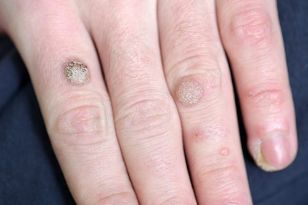
disease definition. Causes of the disease
Wartsare irregular, benign skin lesions with a light body in the form of a localized overgrowth of the upper skin layer (epidermis) with papules (nodules) or plaques.
The incidence of warts in adults is 7-12%, in school-age children up to 10-20%.
Warts are very similar to other skin growths. Usually, a person cannot accurately determine the disease on their own, so a dermatologist must be consulted to make a diagnosis.
The human papillomavirus is the cause of warts. The type of virus affects the type of warts that can develop. Thus, each type of human papillomavirus infects tissues at the location that is most characteristic of it.
| HPV type | Preferred -location |
Types of warts |
|---|---|---|
| 1 | feet, knees, palms, hands, fingers |
Plantar and palmar warts, rarely simple warts |
| 2, 4 | hands, fingers, knees, less often - feet |
Simple warts, occasionally plantar, palmar and mosaic warts |
| 3, 10 | shins, hands, face | Flat warts |
| 7 | hands, fingers | butcher's warts |
| 5, 8, 9, 12, 14, 15, 17, 19-24 |
face, arms, front torso |
Epidermodysplasia verruciform |
Infection with the virus usually occurs through contact - through direct contact with infected and healthy skin (e. g. when shaking hands) or indirectly (through handrails, toys, etc. ). Therefore, you can get infected with the human papillomavirus that causes warts in a variety of places - on public transport, at school, at work, at home, in high-contact places, and in a humid environment (swimming pools, saunas, gyms). A small trauma to the epidermis, through which viruses penetrate, as well as inflammation of the skin contribute to the infection.
Also contributes to the appearance of warts:
- immunodeficiency (including HIV infection);
- warm and humid environment;
- the need for professional contact with meat and fish ("butcher's warts").
Some types of human papillomavirus are transmitted from parents.
But toads and frogs cannot get infected, despite the horror stories we so often fear in childhood - this is one of the most popular myths about this disease that has no basis.
If you experience similar symptoms, contact your doctor. Do not treat yourself - it is harmful!
Wart symptoms
Symptoms vary depending on the type of wart.
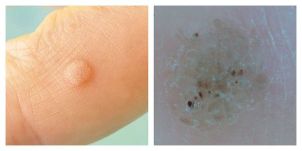
Common wart:
- Round, dense papules of normal color, 1-10 mm and more.
- The surface of the papule is covered with cracks and layers.
- If the papule is on the finger, the pressure disappears and is distorted. The same applies to the palm drawing.
- Simple warts can be found either individually or in multiple parts - they usually appear in the areas of greatest injury (hands, fingers, knees).
- When looking through a dermatoscope, the doctor may see small brown spots - thrombosed (blocked) capillaries. Patients often refer to these points as "roots". This is the main sign for a doctor: it can be used by a dermatologist to distinguish a wart from other similar diseases (e. g. , molluscum contagiosum and keratoma).
Plantar (horny) wart:
- The main symptom that usually leads a patient to see a doctor is pain when pushing and walking.
- Such warts are usually found on the feet.
- When contacting a doctor, a keratinized, uneven plaque of the usual color is usually visible, although in the first stage you can see an even, smooth papule. With cornification, the capillaries can only be seen if the keratinized skin layer is removed.
- The skin pattern on the sole is distorted.
- Plantar warts are usually single, but there are also 2-6 warts;
- These warts are often mistaken for corn (especially dry) - this is the description of the problem patients typically see.
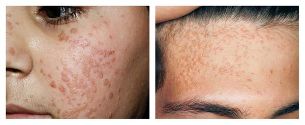
Flat (youthful) wart:
- It looks like a round, clear, smooth papule of normal, pink or brownish color with a size of 1 to 5 mm.
- Appears on hands, shins, very often on the face.
- There are always several such warts - they are in groups.
Epidermodysplasia verruciform (senile wart):
- Large, round, numerous confluent neoplasms of normal pink or brown color.
- Most often appears on the face, arms and upper body.
- Can be confused with keratoma, shingles and skin cancer.
wart pathogenesis
If it gets into the body, the human papillomavirus can be in a latent state for a long time - a person usually does not even know about its existence. When factors favorable to the virus appear, it begins to "multiply" in the epithelium, which leads to tissue changes.
In contrast to other viruses, the human papillomavirus does not destroy the cells of the epithelium itself - they naturally die off during the process of cornification and flaking.
Local factors and the state of the immune system influence the spread of the infection. For example, people with HIV infection or a kidney transplant are more likely to develop warts. In addition, these neoplasms are often difficult to treat. With normal immunity, the virus does not affect the deep layers of the skin, so many people get warts on their own after a few months.
The main stage in the appearance of warts is the acceleration of the rate of cell division and growth with the help of the virus. This rapid metabolism leads to a thickening of the layers of the skin. As the tissue grows in a certain small area, a tubercle called a wart appears.
Classification and stages of development of the wart
There is no generally accepted classification for warts. However, there are several common varieties:
- Wartis the most common type (70% of warts are just them). Such neoplasms cannot be felt and only cause a person aesthetic discomfort.
- Plantar wart- appears on the soles of the feet, is painful and must therefore be treated. A skin trauma from uncomfortable, tight, chafing shoes contributes to the appearance of such a wart.
- Flat warts- are more common in young people and adolescents. This is due to the unstable hormonal background of young people, which affects the whole body. Usually, flat warts are almost invisible.
- Senile warts- are typical of older people. They often appear on the part of the body that is covered with clothing, but they can appear on the face and hands. If there is no discomfort, then such warts should not be treated - healing in the elderly may be much slower than in younger ones due to a slow metabolism.
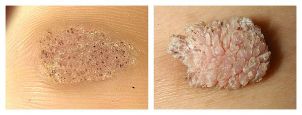
Other authors distinguish several more from these types of warts:
- Mosaic warts(HPV 2, 4) - neoplasms on the palms of the hands and soles of the feet. They look like foci of hyperkeratosis, i. H. Thickening of the stratum corneum (usually in the forefoot) covered with deep fissures.
- Cystic warts(HPV 60) are a very rare type of foot growth. It's a soft knot with cracks. When opened, a white-yellow discharge appears similar to Quark.
- Thread-shaped wartsare thin, horny growths near the mouth, nose or eyes.
- "Butcher" warts(HPV 7) - appear on the hands and fingers of people who are constantly in contact with meat and fish. Shown as hypertrophied neoplasms similar to cauliflower but of normal color.
In addition, different types of warts are distinguished depending on their location.
For example, anogenital warts - tumor-like neoplasms that appear on the genitals (especially where the skin meets the mucous membrane), are a common condition. They are usually caused by HPV types 6 and 11.
Complications of the wart
The main reason patients with warts go to the doctor is an aesthetic defect, which can affect the patient's quality of life, self-confidence and the development of many complexes. Complications include cracking the surface of the wart and adding infection, as well as pain when walking with some types of warts.
Skin warts usually don't degenerate into malignant neoplasms, but they are quite harmless. However, in very rare cases, such a complication can occur in people with suppressed immunity.
Other complications arise when you try to remove the growth yourself. In this regard, inflammation and aesthetic defects in the form of scars can appear, as well as the further spread of the virus through the skin, which allows a person to wake up with several new ones in the morning after self-removal of a wart.
Remember that under the guise of a wart there may be a completely different disease that cannot be determined without the advice of an experienced doctor.
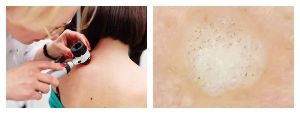
Wart diagnosis
An examination (clinical picture) and anamnesis (anamnesis) are usually sufficient to make a diagnosis.
To confirm the diagnosis, the doctor can perform a histological examination - the examination of the cells of the neoplasm.
It is very important to do differential diagnosis - to distinguish warts from other diseases. For example,common wartsmust be distinguished from the following diseases:
- Molluscum contagiosum- occurs more often on the body and genitals, less often on the hands and feet. It is a hemisphere with an indentation on the surface, when pushed from the sides a whitish "mush" is released.
- Epidermal wart nevus- more often alone, a person has had it since birth. It rises above the surface of the skin and is often covered with hair.
- Basalioma- a tumor in the form of a roll of nodules, which is covered in the middle with a crust. Typical for the elderly.
Palmar-plantar wartsmust be distinguished from the following diseases:
- Keratoderma- large areas of cornification and inflammation of the skin. No clotted capillaries.
- Palmar-plantar syphilids- multiple painless neoplasms, skin peeling along the periphery. The reaction to syphilis is positive.
- maize- normally painless, can only cause pain with vertical pressure.
The doctor must also distinguish other types of warts from a number of diseases. If another pathology is suspected, he can prescribe additional diagnoses (e. g. detection of antibodies against viruses, CT or MRI).
Wart treatment
Warts are treated for aesthetic reasons and to improve the patient's quality of life. It can only be prescribed by a doctor after an examination and an accurately diagnosed diagnosis. Independent attempts to get rid of the wart are unacceptable, since a patient without medical training and equipment cannot accurately determine the disease, and complications after such "treatment" are much more common than with recovery.
There are several different ways to treat warts. All of them are usually done under the supervision of a doctor, and some of them - only in the clinic's treatment room.

Chemical treatments
Milk salicylic collodion and salicylic patches are used to get rid of the wart. The percentage of drugs and how they are used (long-term wearing of patches, applications, etc. ) depend on the prevalence and location of the neoplasm.
Solutions of zinc and 2-chloropropionic acid can also be used. In this case, a chemical composition is applied to the pretreated surface, which remains on the wart until it changes color (depending on the type of wart). The process is repeated several times after 7, 14 and 21 days. The tissue is removed mechanically before each procedure.
Another chemical method is a combination of nitric acid, acetic acid, oxalic acid, lactic acid and copper nitrate trihydrate. In this way, only relatively small neoplasms are treated - up to 5 mm. The solution also remains to change the color of the wart. After 3-5 days, the patient comes for a follow-up appointment; a second procedure may be prescribed within 1-4 weeks.
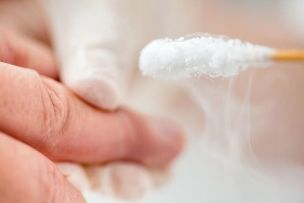
Cryodestruction
This method consists of freezing the wart with liquid nitrogen: a moistened swab is pressed against the damaged skin for 1-5 minutes (covering the surrounding tissue by a few mm). Some lesions require multiple treatments four weeks apart to destroy them.
The main disadvantages of cryodestruction are its painfulness and delayed action compared to other methods, which often only require one removal procedure.
electrocoagulation
Under the influence of an electric current, the wart is removed in layers. Such an operation is performed under local anesthesia.
This method is more effective than cryodestruction, but it has one major disadvantage: electrocautery often leaves scars at the site of the wart removal. For patients looking for cosmetic repair,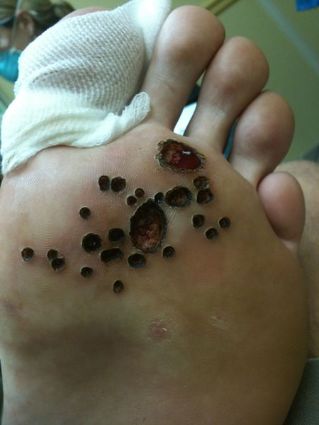 this method is not best.
this method is not best.
Laser destruction
The laser also removes warts in layers. The light guide touches the skin for between a few seconds and three minutes, depending on its size. Then the scab that appears is cut out and the wound floor is treated again with a laser. The patient is then instructed in how to handle the wound. The operation itself is performed under local anesthesia.
radio wave operation
Radio wave surgery is one of the most modern and gentle methods of removing some benign neoplasms, including warts.
The method is based on the generation of electromagnetic waves with different frequencies: from 100 kHz to 105 MHz. During the procedure, the tissues resist the passing waves, which is why molecular energy is released in the cells that heats the skin. Under the influence of heat, the cells actually evaporate - a clean cut is obtained. At the same time, no mechanical forces are exerted on the affected tissue.
Advantages of this method:
- security;
- rapid wound healing;
- good cosmetic effect - scars and scars are excluded;
- relative painlessness - local anesthetic is used before the mini-operation;
- Exclusion of a secondary infection due to an automatic disinfection of the electrode when the device is switched on.
The effectiveness of this method is recognized worldwide. However, it is quite difficult to find a clinic that uses the method of radio wave surgery.
Which treatment method should one choose
All of the above methods have several disadvantages:
- In the first few weeks, the operated area looks unattractive - crusts, darkening of the tissue. This should be taken into account if warts are found on visible parts of the body (e. g. face).
- Unpleasant odor and some degree of pain during the operation.
In addition, each of these methods has contraindications that you must find out about during a preliminary consultation with a dermatologist.
However, the main disadvantage is thehigh probability of recurrence, especially if the warts were widespread and extensive. With each of these methods, doctors now do not fight the root cause of the disease, but its consequencesHuman papillomavirus is incurable.
Therefore, the therapy is aimed at:
- or the destruction of neoplasms that appear at the point of virus introduction;
- either to stimulate the antiviral immune response;
- or a combination of these approaches.
Destructive treatments are the most common. Their efficiency reaches 50-80%.
Childhood is usually not a contraindication to surgical treatment. Therefore, many of them (including radio wave surgery) are also used to treat warts in children. An exception is the chemical removal of warts due to possible side effects of the substance.
What happens after the operation
What to do?Make sure you follow your doctor's advice after each of these operations.
After removing the tumor using one of the methods presented, the doctor usually prescribes treatment of the removal site. It is forbidden to remove "scabs" yourself, moisten the wound and expose it to direct sunlight.
If a patient has warts constantly, he should consult an immunologist - drug therapy that increases the resistance of immunity to the manifestations of the human papillomavirus may be required.
forecast. Prevention
If the patient does not have immunodeficiency, the warts can go away on their own, but this will take a long time - from several months to several years. In 65% of cases, warts regress independently within two years. If the wart is still present after two years, it is recommended to remove it. It is recommended to remove multiple growths immediately.
With normal immunity and the correct method of removal (depending on the size and type of wart), it is possible to remove pathogenic tissue and get a good cosmetic effect. With decreased immunity and other predisposing factors, the remaining human papillomavirus in the body causes relapses.
There is no specific disease prevention. But is infection inevitable?
You can reduce the chance of a virus by following a few rules:
- Do not go barefoot in public places where skin injuries and virus infections are possible (swimming pools, public showers, gyms).
- Choose quality shoes and change them frequently. Try to keep your feet dry. Heat and humidity are excellent breeding grounds for human papillomavirus.
- To avoid periungual warts, only consult a certified nail technician and ensure sterile instruments are used.
According to the WHO (World Health Organization), a tetravalent vaccine against the human papilloma virus is also highly effective for the prevention of anogenital warts. No vaccines are currently available to prevent other types of warts.
If you find a wart, do not try to cauterize, cut, or peel it off yourself. By doing this, you can contribute to the inflammation and further spread of the virus through the skin. After such a "removal", instead of a wart, you can wake up in the morning at ten.














































































